Frederic Church’s Olana in Hudson, New York
FDR and Eleanor in bronze at Visitors’ Center, Hyde Park, New York
The summer following my freshman year of college (1967) I visited the Hudson River Valley for the first time as the horseback riding counselor at a summer camp. I spent almost 10 weeks there, using all my time off to visit various Hudson Valley destinations. I began my discovery of what has become one of my favorite places to visit during that first summer I worked there. Although my fascination with the Hudson Valley began in 1967, it has continued right through to Spring 2025 when I most recently returned to Hyde Park and visited some of my favorite haunts along the Taconic Parkway.
I want to begin with a little history lesson about Henry Hudson, because who really remembers anything about him from 5th grade history textbooks? Once more I rely upon non scholarly sources like the Encyclopedia Britannica and Wikipedia, but I think they are mostly accurate. Hudson was an Englishman, but his most interesting voyage in terms of this post was the one he undertook in 1609 in the employ of the Dutch East India Company. This particular voyage was on a Dutch ship named Halve Maen (Half Moon). Anyone interested in Roosevelt family history knows that both FDR and his father, James Roosevelt, sailed in boats named Half Moon, presumably in honor of Hudson’s ship.
FDR at the wheel of his father’s sailboat Half Moon
Hudson actually made four separate voyages looking for a way through the Arctic ice cap, the last two voyages being searches for the Northwest Passage around the Arctic ice cap through North America that would connect European trade routes with their Asian trading partners. Hudson made his first two attempts at finding an Arctic passage supported by English trading companies. Following conventional wisdom of the day he sailed north and east attempting to find a passage above Russia during the summer months when it was believed the Arctic ice cap would melt. (They were only about 450 years ahead of their time.) Hudson’s final trip to North America, 1610-1611, was perhaps the most significant in terms of the actual area of discovery, but ended in disaster and did not involve the New York estuary. He remained far to the north. The fourth voyage was again undertaken on behalf of Hudson’s English supporters and resulted in the discovery of Hudson Bay. Ultimately, after becoming trapped in the Bay during the winter of 1610-11, Hudson, his son and approximately seven members of his crew became the victims of a mutiny. The last historical account of Henry Hudson indicates he was set adrift in a small boat in Hudson Bay in the spring of 1611. There are some Inuit tales of him and his son living on the shores of the eponymous Bay in Ontario, but no written record exists of what became of him.
In 1609 Hudson set off on his third voyage in the employ of the Dutch East India Company rather than with English support and it is this voyage that matters in terms of the river valley. Ignoring the instructions of his financiers to continue his search north of Russia, Hudson turned west and sailed past Iceland, stopped briefly on the east coast of Greenland and once he reached the coast of Newfoundland he turned to the south. Hudson had apparently deliberately gone rogue. He sailed as far south as the Chesapeake Bay and then turned back to the north. He decided to explore the estuary around Manhattan Island and the river that flowed from the north. This was not a “discovery” because Verrazzano had previously discovered this estuary in 1524. Verrazzano was an Italian by birth but sailed on behalf of King Phillip I of France and claimed the New World for France. The search for the Northwest Passage had thus began long before Hudson’s maiden voyage.
Hudson’s third voyage resulted in the Netherlands being the country responsible for giving the Hudson Valley much of its Dutch European identity. Those ubiquitous “Dutch doors” that still dominate many homes and barns in the valley apparently trace to the same source. Five members of Hudson’s crew took a boat off the ship and rowed as far north as the vicinity of Albany, past modern-day Kinderhook. When they returned, Hudson headed back to Europe, arriving in Dartmouth, England in November. English authorities attempted to seize his log, but Hudson steadfastly refused to surrender to them and ultimately his log was delivered to Amsterdam. His 1609 voyage became the basis of the Dutch claims in North America. Ultimately Manhattan Island became New Amsterdam, the hub of the Dutch fur trading empire until the Dutch lost control under the Treaty of Breda in 1667 ending the Dutch-Anglo war, The Dutch won control of Surinam in South America and Run, an island in the East Indies, part of the Dutch controlled Spice Islands, in exchange for Lower Manhattan which went to the English and became New York. It is believed by some historians that this treaty marked the beginning of British ascendency over the French in North America and certainly over the Dutch, although not before the Dutch had left a firm imprint on the Hudson Valley.
So here I am, having used almost all of my self-allotted 1,000 words on the Henry Hudson History Lesson 1.0 and I haven’t even mentioned all the wonderful places to visit in the Hudson Valley. I will start with Chatham, a lovely village, not right on the river, but a place that will give you a feel for what the Hudson Valley is all about. (what to do in Chatham). Chatham is near Ghent, New York where one can find the Hudson Chatham Winery and some very fine dry white wines. Hudson Chatham Winery. Another big reason to visit this area is Frederic Church’s Olana, a truly magnificent building set in beautifully landscaped grounds. But then what would one expect from the man many consider America’s premier landscape painter and a founder of the Hudson River School of American landscape painters? Who is Frederic Church? Another great spot to spend an afternoon, Poughkeepsie, offers the wonderful experience of a pedestrian bridge high over the Hudson River that one can climb up and then walk across, getting a spectacular view of the valley below. Walkway Over the Hudson. The walkway is accessible to the residents of New York City via a two-hour train ride on the Metro North from the 42nd Street station which brings you right to the bridge. Another spot worth visiting on any trip to the Hudson Valley is the campus at West Point. This aerial tour of the U.S. Military Academy gives a dynamic view of the grandeur of the Hudson River Valley. It only takes a few minutes to view it. aerial tour of West Point. Finally, another thing that draws me to the Hudson River Valley is the collection of outdoor sculpture parks scattered along the valley, perhaps the most prominent being the Storm King Art Center. Outdoor Sculpture Parks
In truth the main draws which bring me back to the Hudson Valley are found at Hyde Park, and not too far from Hyde Park in the town of Rhinebeck. When I visited there this past spring it struck me how little that town and this area had changed since 1967. The whole area, Hyde Park and Rhinebeck, retains the aura of the sort of place where wealthy people at the end of the 19th and during the first half of the 20th century would spend their weekends and leisure time. The three main attractions are the Vanderbilt mansion, Springwood, (FDR’s family home), and Val Kill (Eleanor Roosevelt’s cottage on the more remote grounds of the Roosevelt estate). The Vanderbilt mansion was built in 1898 toward the end of what is known as the Gilded Age. Stanford White, the most famous architect of the period, was involved in its design and construction. It was conceived as a Beaux-Arts interpretation of the Italian Renaissance, designed to secure the Vanderbilts’ place at the pinnacle of the American version of the aristocracy. The spot chosen, Hyde Park, had been the site of a number of earlier homes that conveyed the same sense of British aristocracy, beginning with a home constructed in 1764. The grounds of Hyde Park exude Jane Austen and one expects to find her and her sister Cassandra having a picnic on a blanket spread under one of trees that dot the grounds over the Hudson.
The view from the Vanderbilt Mansion down to the River
The Roosevelt presence at Hyde Park began shortly after the Civil War when FDR’s father bought the land that became the Springwood estate. While the house is lovely, it is not the same as the Vanderbilt estate in any manner. Roosevelt’s father, and FDR himself, were interested in using the estate as a gentleman’s farm and then later in the early 20th century FDR himself became interested in amateur forestry and conservation practices on the estate. Eventually, after he and Eleanor married, construction began at Val Kill. It was originally conceived as a furniture factory for a business that Eleanor started with two other women. After Val-Kill Industries closed in 1936 Eleanor hired someone to design the cottage so that when FDR was not in residence at Springwood she could retire to a place where she could live and work in peace and quiet without having contact with the bustle of Springwood.
Eleanor’s cottage at Val Kill
Springwood Estate
Many observers have commented that the portico and design of the entryway to Springwood has the something that seems to invoke either or both the north and the south entrance of the White House. Perhaps FDR added those white columns as a design element in anticipation of his future role the president of the United States? Who is to say that is not what happened? Go visit Hyde Park and decide for yourself.
ADDENDUM

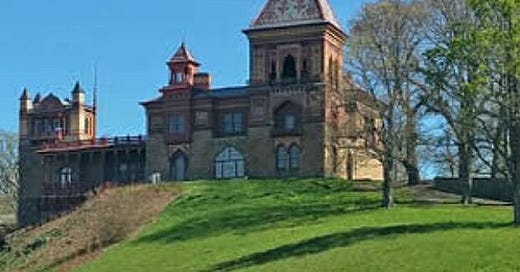




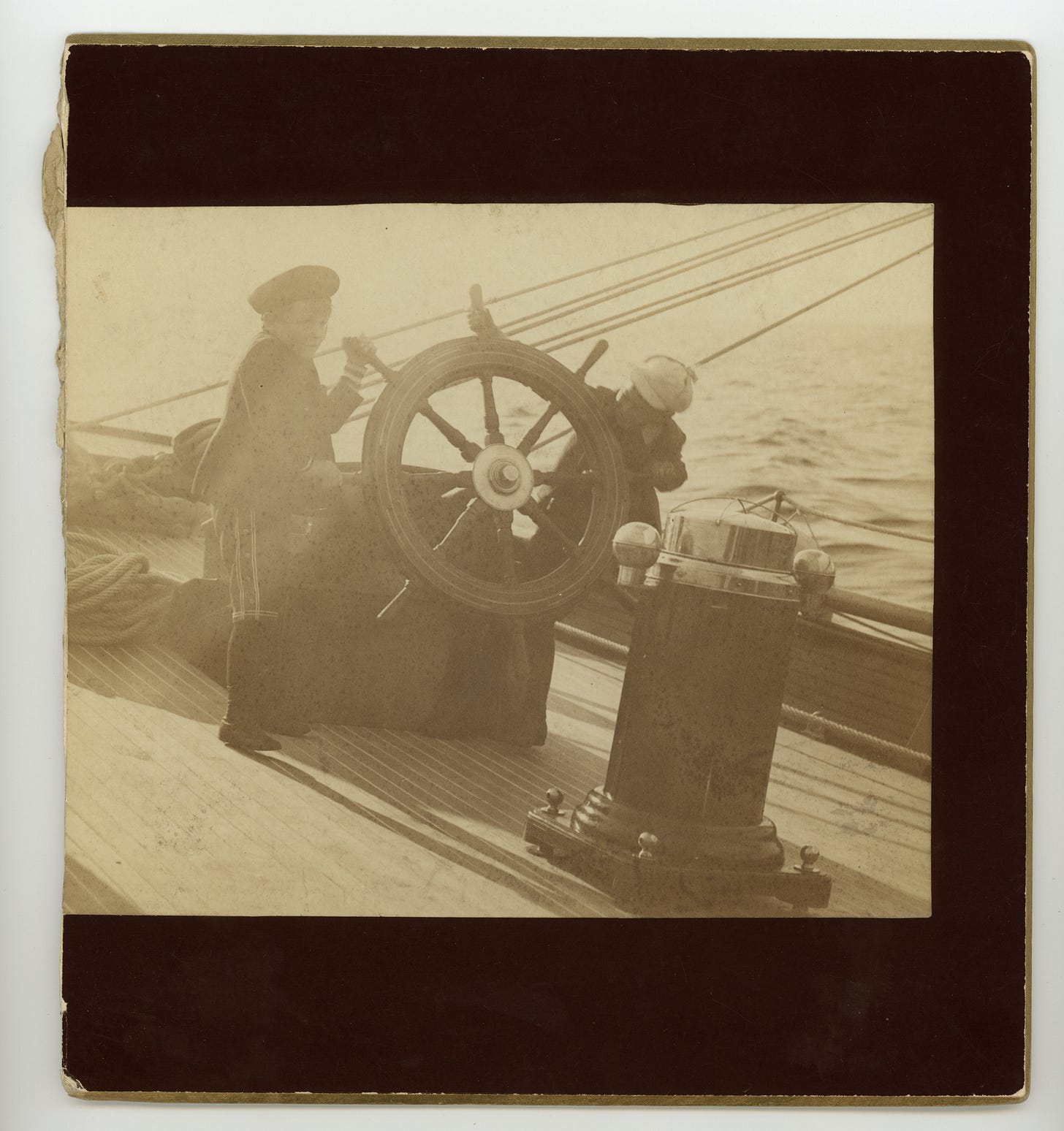
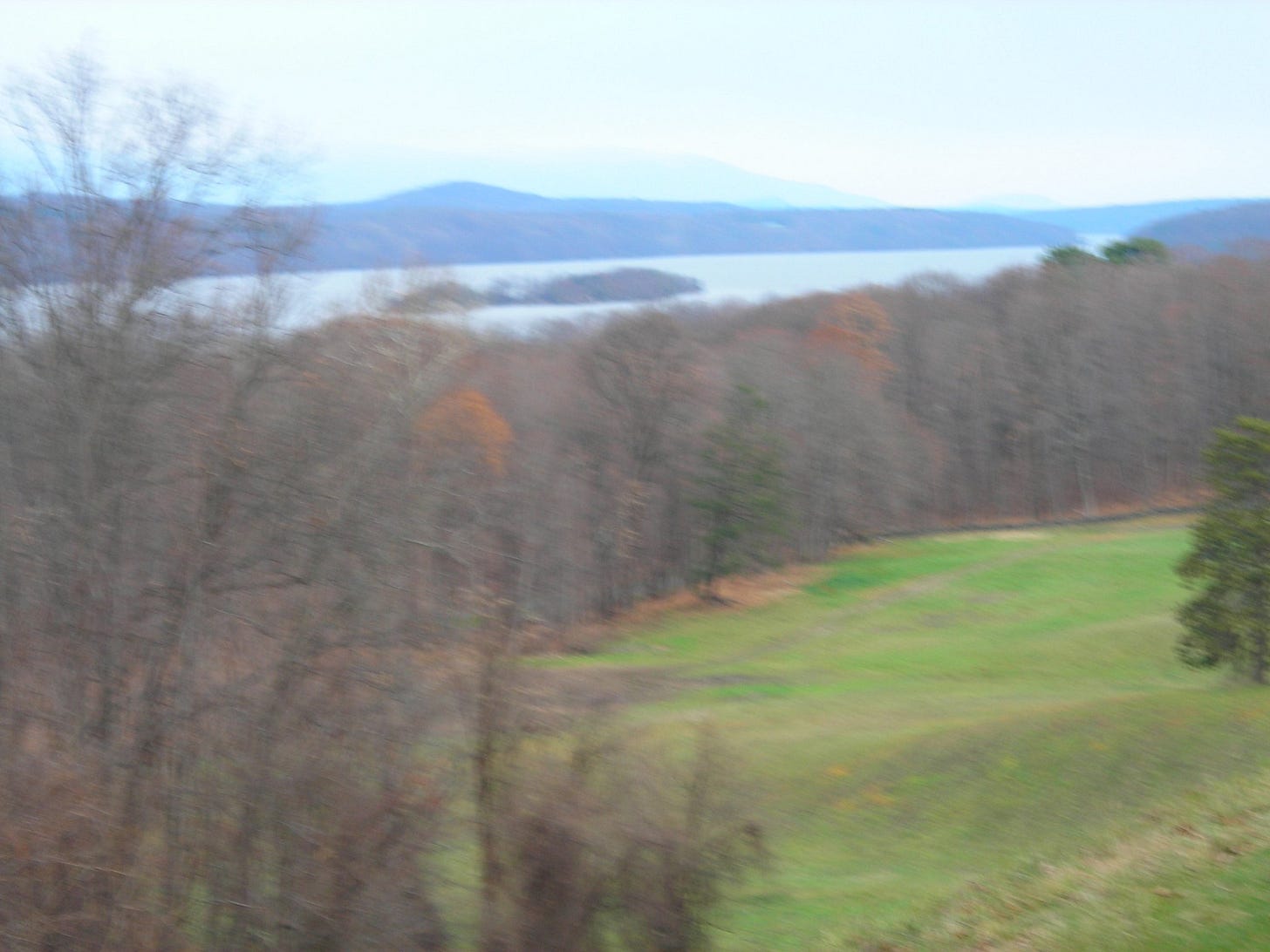
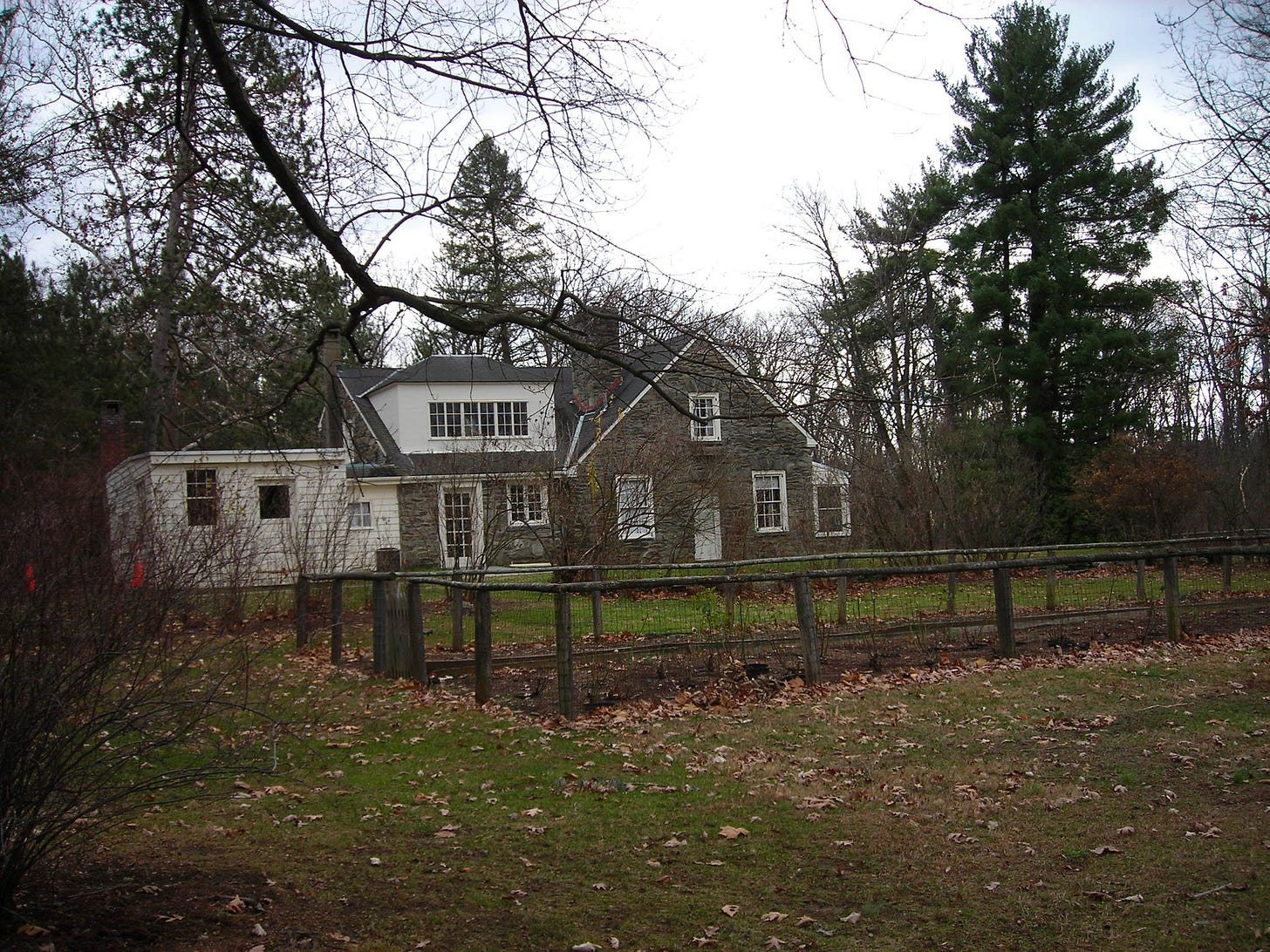
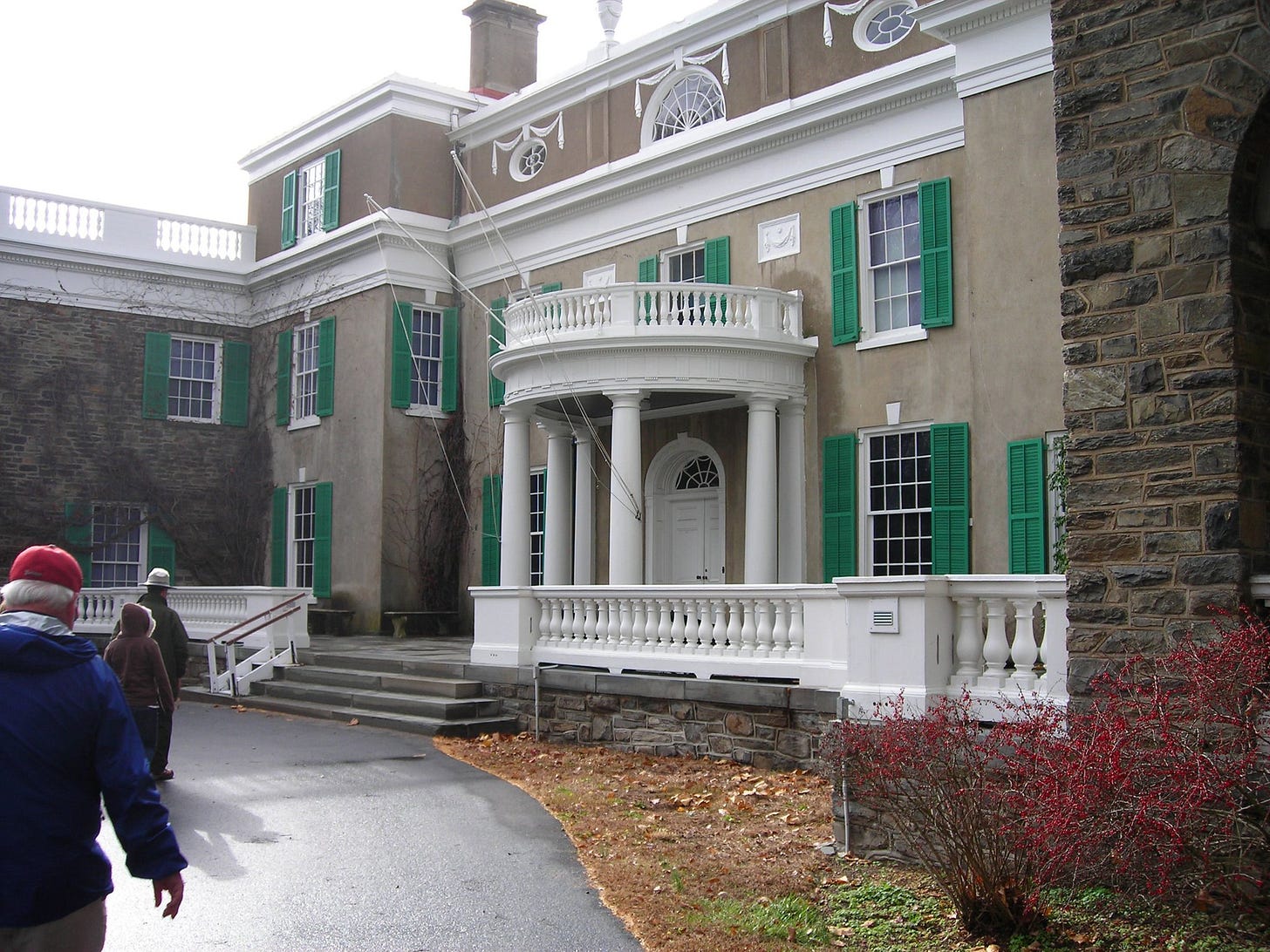
Peg this is brilliant!! I want to visit again now that I know all this history! Thanks so much. I am filled with admiration.
Thanks, MJK! This is a place I would if to visit!